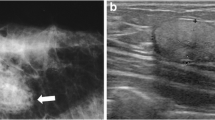Summary
S-100 antigen, originally believed to be unique to the nervous system, has recently been found in cell types of non-neuroectodermal origin such as chondrocytes and adipocytes. These findings suggested the possibility of detecting the antigen in tumours derived from such cells. Using the PAP method and an anti-ox brain S-100, the antigen was found in the cells of human chondrosarcomas, chondroblastomas and liposarcomas. In contrast, fibrous histiocytomas and fibrosarcomas, tested to verify the cellular specificity of the S-100 immunoreaction, did not exhibit S-100-containing cell types. The present data indicate the usefulness of the S-100 antigen as a diagnostic and investigative tool in defined neoplasms of non-neuroectodermal origin, such as chondroid tumours and liposarcoma.
Similar content being viewed by others
References
Cocchia D, Michetti F, Donato R (1981) Immunochemical and immunocytochemical localization of S-100 antigen in normal human skin. Nature (Lond) 294:85–87
Cochran AJ, Wen D-R, Herschman HR, Gaynor RB (1982) Detection of S-100 protein as an aid to the identification of melanocytic tumors. Int J Cancer 30:295–297
Davis BJ (1964) Disc-electrophoresis. II. Method and application to human serum proteins. Ann NY Acad Sci 121:404–427
Donato R, Michetti F (1974) S-100 protein in cerebral cortex synaptosomes. Experientia 30:511–512
Harboe N, Ingild A (1973) Immunization, isolation of immunoglobulins, estimation of anti-body titre. Scand J Immunol 2 (Suppl 1):161–164
Isobe T, Ishioka N, Kocha T, Okuyama T (1982) In: Peeters H (ed) Protides of the Biological Fluids, Vol 30, Pergamon Press, Oxford, pp 21–24
Jacque CM, Kujas M, Poreau A, Raoul M, Collier P, Racadot J, Baumann N (1979) GFA and S-100 protein levels as an index for malignancy in human gliomas and neurinomas. J Natl Cancer Inst 62:479–483
Kahn HJ, Marks A, Thom H, Baumal R (1983) Role of antibody to S-100 protein in diagnostic pathology. Am J Clin Pathol 79:341–347
Kindblom LG, Lodding P, Angerwall L (1983) Clear-cell sarcoma of tendons and aponeuroses. An immunohistochemical and electron microscopic analysis indicating neural crest origin. Virchows Arch [Pathol Anat] 401:109–128
Levine GD, Bensch KG (1972) Chondroblastoma. The nature of the basic cell. Cancer 29:1546–1562
Michetti F, Massaro A, Murazio M (1979) The nervous system-specific S-100 antigen in cerebrospinal fluid of multiple sclerosis patients. Neurosc Lett 11:247–252
Michetti F, Massaro A, Russo G, Rigon G (1980) The S-100 antigen in cerebrospinal fluid as a possible index of cell injury in the nervous system. J Neurol Sci 44:259–263
Michetti F, Dell'Anna E, Tiberio G, Cocchia D (1983) Immunochemical and immunocytochemical study of S-100 protein in rat adipocytes. Brain Res 262:352–356
Moore BW (1965) A soluble protein characteristic of the nervous system. Biochem Biophys Res Commun 19:739–744
Nakajima T, Watanabe S, Sato Y, Kameya T, Shimosato Y, Ishihara K (1982) Immunohistochemical demonstration of S-100 protein in malignant melanoma and pigmented nevus, and its diagnostic application. Cancer 50:912–918
Nakazato Y, Ishizeki J, Takahashi K, Yamaguchi H (1982) Immunohistochemical localization of S-100 protein in granular cell myoblastoma. Cancer 49:1624–1628
Ornstein L (1964) Disc-electrophoresis. I. Background and theory. Ann NY Acad Sci 121:321–349
Springall DR, Gu J, Cocchia D, Michetti F, Levene A, Levene MM, Marangos PJ, Bloom SR, Polak JM (1983) The value of S-100 immunostaining as a diagnostic tool in human malignant melanoma. A comprehensive study using S-100 and human-specific enolase anti-bodies. Virchows Arch [Pathol Anat] 400:331–343
Stefansson K, Wollman RL, Moore BW, Arnason BGW (1982a) S-100 protein in human chondrocytes. Nature (Lond) 295:63–64
Stefansson K, Wollmann RL, Jerkovic M (1982b) S-100 protein in soft-tissue tumors derived from Schwann cells and melanocytes. Am J Pathol 106:261–268
Sternberger LA, Hardy PH Jr, Cuculis JJ, Meyer HG (1970) The unlabelled antibody enzyme method of immunohistochemistry. Preparation and properties of soluble antigen-antibody complex (horseradish peroxidase-antihorseradish peroxidase) and its use in identification of spirochetes. J Histochem Cytochem 18:315–333
Zomzely-Neurath CE, Walker WA (1980) Nervous system-specific proteins: 14-3-2 protein, neuron-specific enolase, and S-100 protein. In: Bradshaw RA, Schneider DM (eds) Proteins of the nervous system. Raven Press, New York, pp 1–57
Zuckerman JE, Herschmann HR, Levine L (1970) Appearance of a brain-specific antigen (the S-100 protein) during human foetal development. J Neurochem 17:247–251
Author information
Authors and Affiliations
Rights and permissions
About this article
Cite this article
Cocchia, D., Lauriola, L., Stolfi, V.M. et al. S-100 antigen labels neoplastic cells in liposarcoma and cartilaginous tumours. Vichows Archiv A Pathol Anat 402, 139–145 (1983). https://doi.org/10.1007/BF00695055
Accepted:
Issue Date:
DOI: https://doi.org/10.1007/BF00695055




